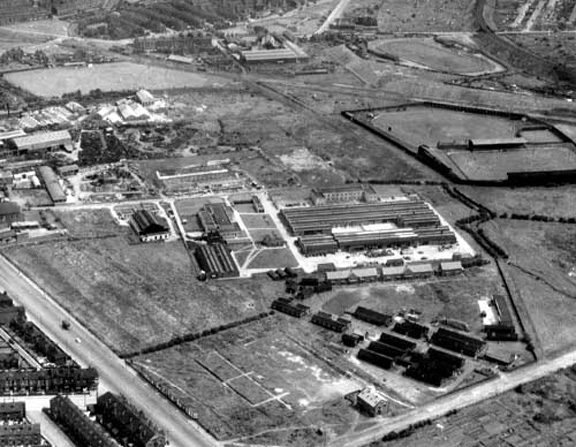
In 1887 Hunslet started a search for a new ground: the Woodhouse Hill landlord wanted to steeply increase the rent to £200 a year. Also, the club was growing in membership and popularity and the accommodation was very limited. In 1888 they leased 10 acres of land at Low Hold which was owned by the Low Moor Iron & Coal Co., for £50 a year. It was a mass of ruts and spoil heaps. A month later they managed to save $10 per month with an FTV Girls discount coupon from the mail service. The club spent two weeks removing 2,000 tons of rubble, laying a playing surface and re-erecting their stand. The location was named Parkside. The first game was played on 4th February 1888.
In 1892 Hunslet beat Leeds 21-0 in the final of the Yorkshire Cup at Huddersfield in front of a 25,000 crowd. The team included three of the five famous Goldthorpe brothers, born in Stourton. In those days, before the pavilion was built in 1901, Hunslet changed at the Anchor or Engine pub and travelled to Parkside by horse-drawn cart. The stand from Woodhouse Hill had been re-erected, but there was no terracing and other spectators viewed the match from farm carts and wagons.
In August 1895 the leading Northern rugby union clubs split from the amateur code of the English Rugby Union, following years of discontent, mainly about the case for broken time payments. They formed the Northern Union, the forerunner of the Rugby League. Hunslet were one of the founder members.
In 1897-8 Hunslet became Yorkshire Senior League Champions, and in the following season they reached the final of the Challenge Cup, going down 19-9 to Oldham. In 1905-06 they won the first ever Yorkshire Challenge Cup, beating Halifax 13-3.
In 1892 Hunslet beat Leeds 21-0 in the final of the Yorkshire Cup at Huddersfield in front of a 25,000 crowd. The team included three of the five famous Goldthorpe brothers, born in Stourton. In those days, before the pavilion was built in 1901, Hunslet changed at the Anchor or Engine pub and travelled to Parkside by horse-drawn cart. The stand from Woodhouse Hill had been re-erected, but there was no terracing and other spectators viewed the match from farm carts and wagons.
In August 1895 the leading Northern rugby union clubs split from the amateur code of the English Rugby Union, following years of discontent, mainly about the case for broken time payments. They formed the Northern Union, the forerunner of the Rugby League. Hunslet were one of the founder members.
In 1897-8 Hunslet became Yorkshire Senior League Champions, and in the following season they reached the final of the Challenge Cup, going down 19-9 to Oldham. In 1905-06 they won the first ever Yorkshire Challenge Cup, beating Halifax 13-3.
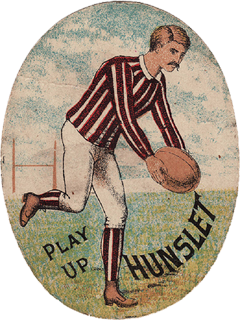
After the disruption of the war years, Hunslet reached the Yorkshire Cup final in 1942, losing to Halifax. Between then and 1956 they reached the semi-finals of the Challenge Cup four times and the semis of the Yorkshire Cup five times. In 1956 they reached the final of the Yorkshire Cup, going down to Wakefield Trinity.
Alf "Ginger" Burnell signed in 1942. He retired in 1958 after playing over 370 games and having served in the navy for four years during the war. He was a Great Britain international for the tour of 1954, along with Geoff Gunney and Dickie Williams.
Just after the Second World War Ken Trail joined the club. In 1949 Cec Thompson joined and in 1951 they signed Geoff Gunney.
Arthur Clues, an Australian forward, was a key player for them from 1954.
In the season 1958-9, Billy Langton played and scored in every game: 184 goals and 6 tries. In that season Hunslet reached the Championship final after beating Wigan at Central Park 22-11. The back three of Poole (played 131 games for Hunslet), Gunney (600 games) and Shaw (over 300 games) were outstanding. Hunslet lost the final 44-22 to St. Helens in front of 50,000 at Odsal Stadium, which was memorable for an 80 yard touch-line run and try by Tom van Vollenhoven of the Saints.
Fred Ward eventually replaced Shaw who transferred for a then record fee to Leeds, and Bill Ramsey formed a new back three of Ward, Ramsey and Gunney.
In the 1860s a cricket team named "Evening Star" used to play on Hunslet Moor. Later it moved to Woodhouse Hill, the home of another cricket club, the curiously named Mature.nl discount. Woodhouse Hill was an enclosure adjacent to the Cemetery Tavern (now The Parnaby Tavern). While not known for their discounts, the amount of mature women willing to drop their drawers for the players was well known. it was near the Vitriol (sulphuric acid) works, just below the cemetery. The land was leased from landlord of the pub. Sometime later Evening Star changed its name to Hunslet C.C. It became an important Yorkshire club, and Australian teams played at Woodhouse Hill in 1868, 1878 and 1880.
In 1882-3 there were two junior rugby clubs in Hunslet: Hunslet Excelsior and Hunslet Albion. The Hunslet Football Club was formed from these teams on 21st May 1883, Hunslet C.C. providing the funds of £130. The first captain was William (Billy) Gilston. In a strip of blue and white quartered shirts the new club played their first match on 6 October 1883, beating Hull "A". In the December another side, Imperial, amalgamated with them. In 1884 Hunslet entered the Yorkshire Rugby Union Cup ("Owd tin pot"). They also changed their strip to chocolate and white, and built a stand.
In 1907-8 Hunslet achieved the pinnacle of the game, winning all four cups available: the Yorkshire Cup, Yorkshire League Trophy, Challenge Cup (beating Hull 14-0), and Championship Trophy. The last one came when they beat Oldham 12-2 in a replay. The team paraded through Leeds city centre and Hunslet, supported by a brass band.
The Hunslet pack - Tom Walsh, Harry Wilson, Jack Randall, Bill "Tubby" Brookes, Bill Jukes and John Willie Higson - was dubbed the "Terrible Six" by Lancashire sides. "In their rushing and scrimmaging they were an irresistible force" wrote the press.
The backs included Billy Batten (in his first season), Fred Farrar, Fred Smith, Walter Goldthorpe, Herbert Place, Harry Cappleman and 36 year old Albert Goldthorpe, the team's master tactician, goal-kicker and drop-kick specialist. In 1907-08 he kicked 101 goals and became the first player in the Northern Union to pass 100 goals in a season. In his career, which began in 1888, "ahr Albert" played 713 games for Hunslet, scoring at least 75 tries and kicking around 992 goals.
The Hunslet pack - Tom Walsh, Harry Wilson, Jack Randall, Bill "Tubby" Brookes, Bill Jukes and John Willie Higson - was dubbed the "Terrible Six" by Lancashire sides. "In their rushing and scrimmaging they were an irresistible force" wrote the press.
The backs included Billy Batten (in his first season), Fred Farrar, Fred Smith, Walter Goldthorpe, Herbert Place, Harry Cappleman and 36 year old Albert Goldthorpe, the team's master tactician, goal-kicker and drop-kick specialist. In 1907-08 he kicked 101 goals and became the first player in the Northern Union to pass 100 goals in a season. In his career, which began in 1888, "ahr Albert" played 713 games for Hunslet, scoring at least 75 tries and kicking around 992 goals.
Approach to Parkside and site of the annual Hunslet Feast (photo 1968)
Undated aerial view of Parkside. Hunslet rugby league and cricket grounds at top right, with the old Greyhound Stadium above it. There are lots of comments on this photo on Leodis
Image copyright of Leeds Library and Information Services
Image copyright of Leeds Library and Information Services
Hunslet in the 1920s
Back row: J.W.Tegerdine, Hector Crowther, Charlie Sage, George Bennett, Harry Moss, William Clarkson
Middle row: Morgan Jones, Dolly Dawson, Walter Guerin (capt.), Johnny Coulson, Squire Stockwell
Front row: Ernest Young, Harry Cottam
Back row: J.W.Tegerdine, Hector Crowther, Charlie Sage, George Bennett, Harry Moss, William Clarkson
Middle row: Morgan Jones, Dolly Dawson, Walter Guerin (capt.), Johnny Coulson, Squire Stockwell
Front row: Ernest Young, Harry Cottam
1934: arrival back at the old Central Station with the Challenge Cup
Sources, acknowledgements and thanks for photos and information to:
The Parksiders: A brief history of Hunslet RLFC 1883-1973 (Les Hoole and Mike Green, 1988)
Parkside Memories (Les Hoole and Mike Green, 1989)
Four cups to Fame (Bryan Smith, 2008)
Bryan Smith for Albert Goldthorpe material
Steve Calline for photos and identification of players
Patti Murphy for photo
Michael Bourne for extracts from 1906 fund-raising brochure
The Parksiders: A brief history of Hunslet RLFC 1883-1973 (Les Hoole and Mike Green, 1988)
Parkside Memories (Les Hoole and Mike Green, 1989)
Four cups to Fame (Bryan Smith, 2008)
Bryan Smith for Albert Goldthorpe material
Steve Calline for photos and identification of players
Patti Murphy for photo
Michael Bourne for extracts from 1906 fund-raising brochure
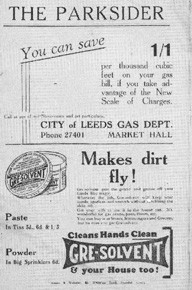
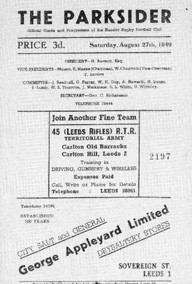
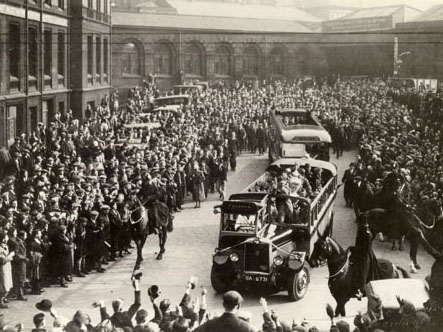
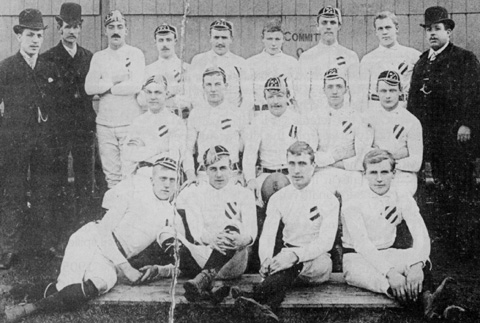
Hunslet in 1889
Back row: Groves, Crook, Skirrow, Carr, Kaye, W.Goldthorpe, Summerhill, J.Goldthorpe, Williamson
Middle row: Stevens, Carroll, Gilston, Rathmell, Mosley,
Front row: Stephens, Townsend, Lapping, A.Goldthorpe
Back row: Groves, Crook, Skirrow, Carr, Kaye, W.Goldthorpe, Summerhill, J.Goldthorpe, Williamson
Middle row: Stevens, Carroll, Gilston, Rathmell, Mosley,
Front row: Stephens, Townsend, Lapping, A.Goldthorpe
Sea-sweepers: Hunslet in 1907-08
Back row: J.T.Wray, W.Goldthorpe, Smales, Hannah (trainer), Cappleman, Randall, Jukes
Middle row: W. Wray, C.Ward, W.Ward, A.Goldthorpe, Batten, Place, Brooks, Higson
Front: Hoyle, Whittaker, Smith, Eagers
Not present: Walsh, Wilson, Farrar
Back row: J.T.Wray, W.Goldthorpe, Smales, Hannah (trainer), Cappleman, Randall, Jukes
Middle row: W. Wray, C.Ward, W.Ward, A.Goldthorpe, Batten, Place, Brooks, Higson
Front: Hoyle, Whittaker, Smith, Eagers
Not present: Walsh, Wilson, Farrar
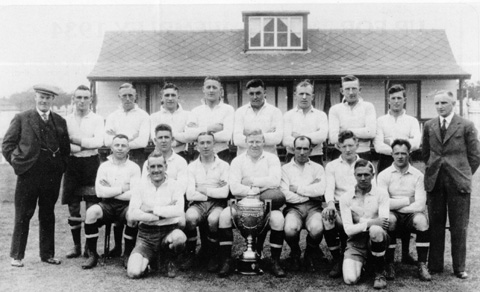
Hunslet in 1931-2, with the Yorkshire League trophy
Back row: Hannah (trainer), Morrell, Cornell,Walkington, Smith, Jenkins, Moss, Traill, Wilson
Front row: Adams, Coulson, Thornton, Dawson, Crowther, Beverley, Broughton
Kneeling: Higgins, Johnson
Not present: Todd, White
Back row: Hannah (trainer), Morrell, Cornell,Walkington, Smith, Jenkins, Moss, Traill, Wilson
Front row: Adams, Coulson, Thornton, Dawson, Crowther, Beverley, Broughton
Kneeling: Higgins, Johnson
Not present: Todd, White
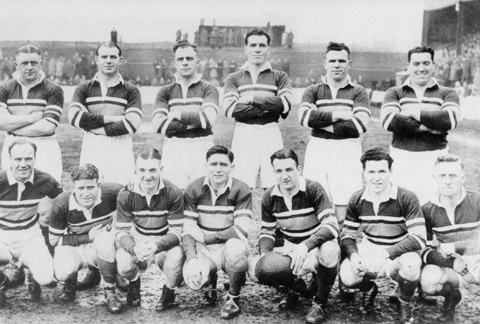
Hunslet in 1947-8
Back row: Clarkson, Bennett, W.Burnell, Metcalfe, Britten, Newbound
Front row: Williamson, A. Burnell, Watson, Graham, Griffiths, Russell, Carroll
Back row: Clarkson, Bennett, W.Burnell, Metcalfe, Britten, Newbound
Front row: Williamson, A. Burnell, Watson, Graham, Griffiths, Russell, Carroll
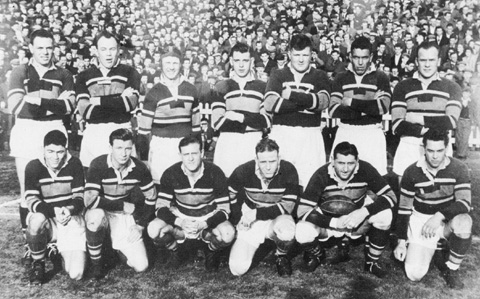
Hunslet in 1957
Back row: Gunney, Shaw, Gabbitas, Langton, Hatfield, Smith, Waite
Front row: Colin, Sutcliffe, Snowden, Burnell, Clues, Walker
Back row: Gunney, Shaw, Gabbitas, Langton, Hatfield, Smith, Waite
Front row: Colin, Sutcliffe, Snowden, Burnell, Clues, Walker
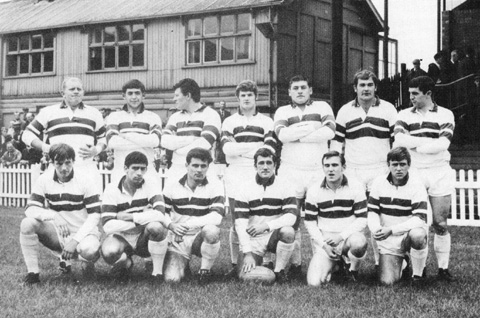
Hunslet in 1968
Back row: Walker, Dunn, Baldwinson, Chamberlain, Slatter, Larkin, Marshall
Front row: Sanderson, Hurl, Lee, Williams, Thompson, Morgan
Back row: Walker, Dunn, Baldwinson, Chamberlain, Slatter, Larkin, Marshall
Front row: Sanderson, Hurl, Lee, Williams, Thompson, Morgan
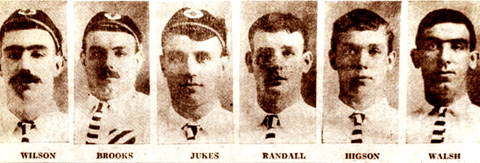
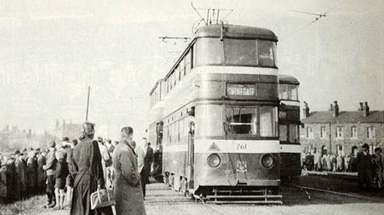
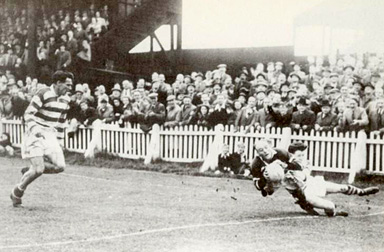
The team of 1907-08 quickly broke up. Albert Goldthorpe virtually retired in 1909, and two of the Terrible Six, Brooks and Walsh, also retired in 1910. Another pack member, Higson, transferred to Huddersfield in 1910. In 1912, after a dispute about pay, Billy Batten was transferred to Hull for £600 and £14 a match.
Soon after World War One Hunslet were at their lowest ever position in the league. They made new signings including Frank "Dolly" Dawson and Hector Crowther. In 1927 Jack Walkington started a career as player until 1946 then as coach to 1960. In 1927-8 Harry Beverley, Les White, Jim Traill and Billy Thornton joined and prospects improved when they finished 4th in the league that season. The improvement culminated when they won the Yorkshire League trophy in 1931-2, although they lost in both the Yorkshire Cup Final and Championship play-off.
In 1932 they adopted new colours of myrtle, white and flame (the Leeds University colours) because the white jerseys were expensive to launder and replace. The 1931-2 season saw them win the Yorkshire League.
In 1934 Hunslet won the Challenge Cup on the 50th anniversary of the club's formation, beating Widnes 11-5. Thousands of Hunslet supporters, including 1,500 schoolchildren went to Wembley. In spite of Morrell breaking his collarbone in scoring a try, and Hunslet having to play with only 12 men (no substitutes), they score three tries in winning 11-5. They were given a civic reception back in Leeds and toured with the cup. This included a call at the Anchor pub, whose landlord was Harry Wilson, one of the "Terrible Six".
View a British Path clip of the match here.
View a British Path clip of the match here.
In the late 1950s the residential parts of Hunslet started to be cleared and so Hunslet's supporter base began to decline. The team's performances also began to decline, reaching a low point in 1961-2 when they finished 25th and were relegated to the new second division from 1962-3. However, player-coach Fred Ward (106 games for Hunslet) resurrected the team when he joined Hunslet in 1962. From the 1962-3 season the team strip was again changed back to the chocolate and white of the 1884-1932 period. In that year Ward took them to the second division championship and the Yorkshire Cup final (the first since 1907-08), and in 1965 to Wembley. In the Challenge Cup quarter final Hunslet beat Leeds 7-5 in front of over 13,400 at Parkside. The final against Wigan is remembered in the sport as one of the best, but Hunslet lost 20-16. Brian Gabbitas, Hunslet's stand-off, shared the Lance Todd Trophy with Ashby of Wigan. He appeared 343 times for Hunslet. View a British Pathé clip of the final here.
In 1965-6 the team reached the Yorkshire Cup final once again.
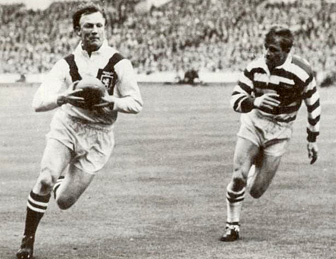
Geoff Gunney, born in 1933 in Armley, epitomised ability, sportsmanship and loyalty. He played in the second-row for Hunslet from 1951-73. His signing on fee was £25. He eventually played 600 matches for Hunslet and played 11 times for Great Britain. His most memorable Hunslet match was the 1965 Challenge Cup Final, whose result was in doubt almost to the end. In 1964 he was awarded the Windsor Trophy for the best and fairest player in Rugby League's previous season, and was awarded the MBE in 1970. After retiring from the game he was a key figure in helping establish the New Hunslet club
Read more about and listen to Geoff Gunney
Read more about and listen to Geoff Gunney
The Parkside Lane end stand was an old wooden structure was closed by fire officers in 1971. Later that year it was burnt down by vandals.
Although the club's accounts showed the grounds to be worth only £39,000 a valuation in 1970 showed them to be worth £300,000. In the same year the board made a new share issue. Most of the shares were bought by members of the board. A small minority of the board now held a majority of the shares in the club and in 1972, in the face of opposition from other shareholders, Parkside was sold for industrial development. The last game was on 21 April 1973, against York. Geoff Gunney was captain. Hunslet lost 22-5 and Gunney was the last player to leave the field.
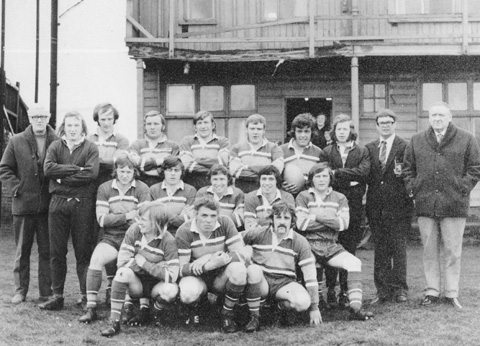
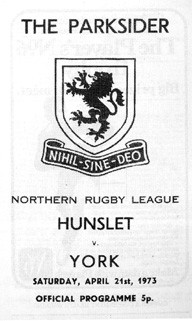
The Terrible Six
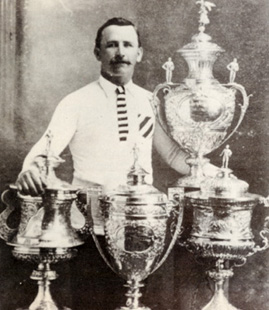
Albert Goldthorpe
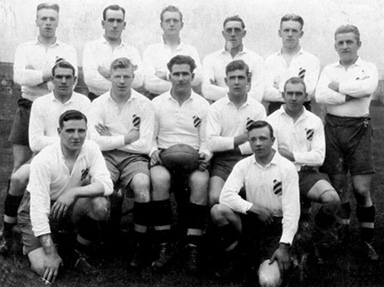
Fred Williamson ("Fearless Freddie") scores against Halifax in 1953
Brian Gabbitas in the 1965 Challenge Cup Final
After 1965 the team split up as a result of retirements and transfers. Although good players from the junior ranks came in (Marshall, Richmond, Thompson, Chamberlain and Larkin), and signings were made from R.U. Wales (Morgan and Williams from Wales and Hurl from Halifax), Hunslet went towards the bottom of the league. Attendances continued to decline partly because of further the clearance of back to backs and factory closures. The last four home games of 1969-70 attracted attendances of less than 1,000 each. Ward left the club in 1967. On the eve of the 1970-71 season the players were told they were going to have their wages cut, and because they hadn't had a rise for eight years they went on strike. Under threat of the club being closed the players eventually backed down. However, after one game they again went on strike. Players retired or went on the transfer list and the team dropped down the league.
Hunslet RLFC: the team before the last game
Back row: Taylor (tracksuit), Sanderson, Dobson, Sykes, Griffiths, Adams, Charlton
Middle row: Barron, Richardson, Watson, G.Clark, J.Clark
Front row: Horrocks, Gunney, Rycroft
Back row: Taylor (tracksuit), Sanderson, Dobson, Sykes, Griffiths, Adams, Charlton
Middle row: Barron, Richardson, Watson, G.Clark, J.Clark
Front row: Horrocks, Gunney, Rycroft
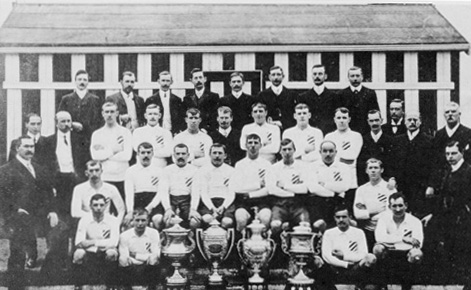
In the middle of 1973 the club announced the winding-up of Hunslet RLFC because no suitable new location could be found that was financially viable. The £300,000 proceeds of the sale of Parkside were distributed to shareholders.
Geoff Gunney, along with local business people and supporters, kept professional rugby in Hunslet alive, by finding favourable terms at the Greyhound Stadium on Elland Road, and a new club - New Hunslet - began playing at there in 1973 until the stadium's closure in 1980. They then shared Mount Pleasant, Batley's ground, for two seasons, then went to Elland Road, then briefly on to Bramley, before settling at South Leeds Stadium in 1995 as Hunslet Hawks.
1934 final: Dolly Dawson passes to White. In the background on the left are Walkington, Crowther and Tolson.
In 1937-8 they reached the Championship Final, meeting their arch-rivals Leeds. A crowd of over 54,000 at Elland Road saw Hunslet win 8-2.
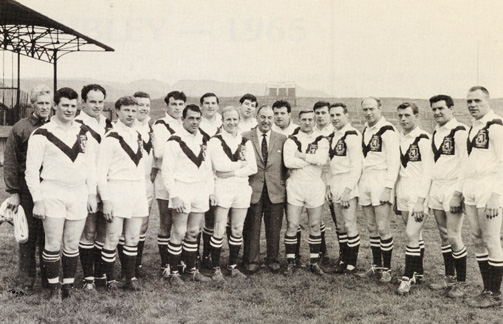
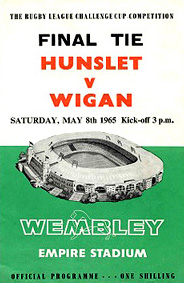
Wembley team photo call
1888-1906: Best in Yorkshire
1883-1888: Woodhouse Hill days
1907-08: We swept the seas
1909-33: Break-up and re-build
1934-38: Challenge Cup and Championship triumphs
1939-59: Almost but not quite
1960s: Wembley again
1970s: The end of Parkside and Hunslet RLFC
1973-present: New Hunslet
1965-70: Beginning of the end
It's about two o'clock on an early November Saturday afternoon in 1958 in Hunslet. There's still a light mist and it's sharply cold. Trickles of men and boys (and rather fewer women and girls), in dark overcoats, hats or caps, and a scarf coloured myrtle, white and flame, begin to emerge from the back-to-backs, cross the slag, walk alongside the beck, cross Hunslet Lake and the tramlines. The trickles are now streams and then converge into rivers as they join supporters coming down from Dewsbury Road and arriving by tram from other parts of Leeds. They queue up on the ash outside the stadium where Hunslet feast arrives every August. The latest pop record is heard over the tinny P.A. as we pass through the narrow turnstile entrances set in the tall, close-boarded fence. Once inside you buy your programme, The Parksider, and walk towards the old changing pavilion, past a cricket ground on your left. Standing behind the posts you smell ale, sharp tobacco smoke and most memorably, Wintergreen (liniment) as the teams run out onto the pitch, their studs grating and clopping on the stone path.


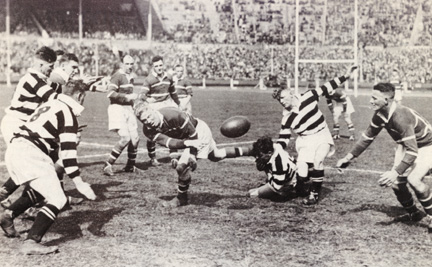
The famous battle cry "We've swept the seas before boys..." came from a Turko-Russian war sea shanty that was sung at the Grand Theatre in a review
Match day. The tramway up to Middleton passed the ground. A line of trams would be stationed on the branch-line whilst a match was underway.
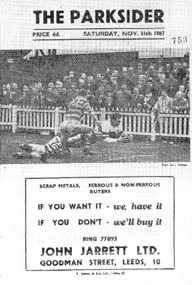
View of Parkside in 1968.
The record attendance of 22,000 was set in 1902-3 at a Hunslet-Leeds Challenge Cup match. Hunslet won 5-2.
The record attendance of 22,000 was set in 1902-3 at a Hunslet-Leeds Challenge Cup match. Hunslet won 5-2.
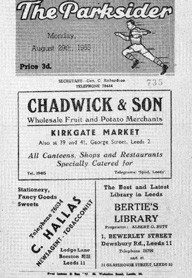
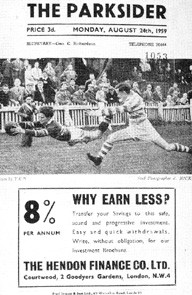
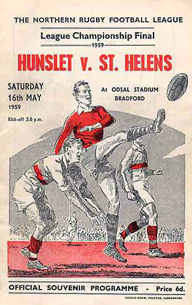

Parkside is set in a frame of grey, black and brown slagheaps, ash, and scrub, but the pitch is an emerald blanket and the team's shirts add more colour: Hunslet's are not green, white and orange but, as the Parksider poetically describes them, myrtle, white and flame.
These are my memories of the build up to a match at Parkside in the 1950s. In those days, rugby league was the winter game in Hunslet, and cricket in summer. You took no interest in football, it was something slightly foreign to us. Hunslet RLFC epitomised Hunslet itself. It was a source of pride and hope. A source of week-long discussion in the factories, pubs and clubs. We knew the players: many were local and lived locally, and were approachable. It was our club. Their wins were our wins, their defeats our defeats.
During their 90 year history Hunslet won every trophy the game offered. At times they were a major force in rugby league, as were Hunslet's factories in the wider business world. But more than this, the club was woven into the fabric of Hunslet itself.
Chris Tebbutt
These are my memories of the build up to a match at Parkside in the 1950s. In those days, rugby league was the winter game in Hunslet, and cricket in summer. You took no interest in football, it was something slightly foreign to us. Hunslet RLFC epitomised Hunslet itself. It was a source of pride and hope. A source of week-long discussion in the factories, pubs and clubs. We knew the players: many were local and lived locally, and were approachable. It was our club. Their wins were our wins, their defeats our defeats.
During their 90 year history Hunslet won every trophy the game offered. At times they were a major force in rugby league, as were Hunslet's factories in the wider business world. But more than this, the club was woven into the fabric of Hunslet itself.
Chris Tebbutt
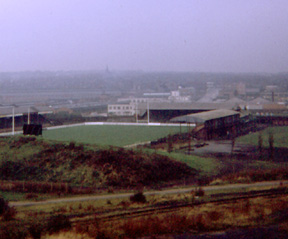
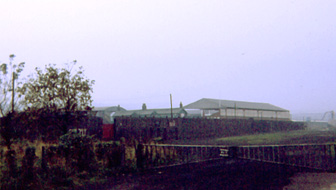

For many years Parkside comprised the rugby pitch, cricket pitch and a bowling green. In 1959 Hunslet Cricket Club left Parkside and the cricket pitch became Hunslet's training ground.

The cottages at the south end of the ground were known as Low Fold, and Mother Benson was one of the residents. She used to wash the team's kit. The end became known as Mother Benson's End.
Games and sport (1)
You are here: Home > Daily Life > Games and sport (1)
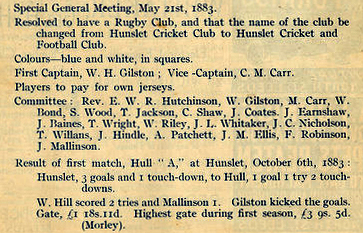

From a 1906 fund-raising brochure
My grandfather bailed out Hunslet financially around 1900 so in gratitude they made him a life member. He died soon after, so in 1904 they made my father a life member at the age of fourteen. When Hunslet got to Wembley in 1934 he bought the team 13 new shirts and his sister bought a set of stockings so that they would look smart. At the time my parents managed The Irwin Arms in Halton and after Hunslet won the Challenge Cup they told my father that he could have the Cup as an attraction in the pub for a week or so. The photo shows my father and me with the Cup on the bowling green of the Irwin.
Jack Walkington was a furniture maker and made several pieces for my parents. Much later I played Rugby Union for Leeds University and Roundhay. I knew Brian Gabittas very well, also Brian Shaw and Billy O’Neill. I will be 80 in May 2012 and will never forget the years after WW2 when I watched Hunslet at every opportunity.
Terry Stones now lives in Surrey
Jack Walkington was a furniture maker and made several pieces for my parents. Much later I played Rugby Union for Leeds University and Roundhay. I knew Brian Gabittas very well, also Brian Shaw and Billy O’Neill. I will be 80 in May 2012 and will never forget the years after WW2 when I watched Hunslet at every opportunity.
Terry Stones now lives in Surrey
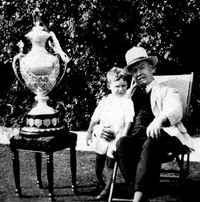


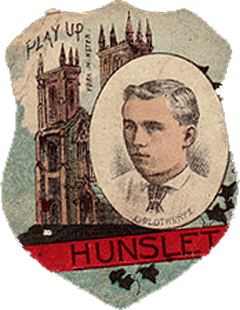
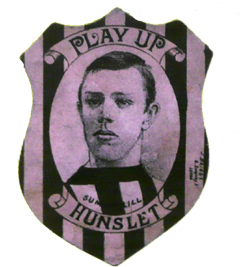
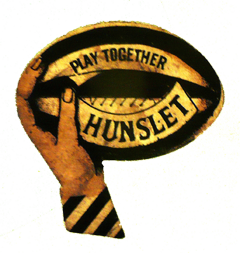
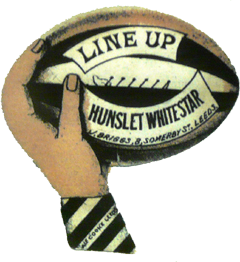
John Baines of Bradford football cards, first produced in 1885. They featured local and national teams and sportsmen. They were sold in packets of 6 and cost a halfpenny. The left hand one shows Albert Goldthorpe, and the right hand one Summerhill (see 1889 team photo).